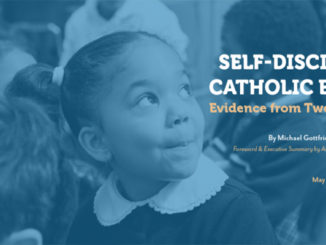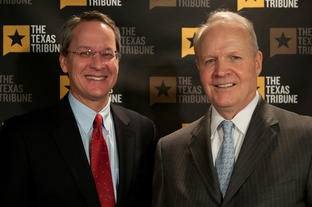
In a recent study, Lindsay, Blom, and Tilsley present an impressive analysis of the disparities between the racial composition of American children and the racial composition of the American teaching force. [1] Using data from the American Community Survey, they show that in 2015 just over half of American children aged 5 to 17 were white, but nearly 80 percent of young teachers (whom they define as individuals aged 25 to 34, with a bachelor’s degree, and teaching at the prekindergarten through high school level) were white. Meanwhile, while black students comprise around 13 percent of all school-aged children, black teachers represent only around 8 percent of all young teachers, and while Hispanic students comprise around 24 percent of all school-aged children, Hispanic teachers represent only around 9 percent of all young teachers. Asian teachers are slightly underrepresented relative to the percentage of Asian students in the population.
Racial and ethnic differences in the pipeline of teachers
Lindsay, Blom, and Tilsley then seek to understand where in the pipeline for teachers do these gaps emerge. They begin by looking at the likelihood that young people from different racial and ethnic groups would be in a position to potentially become teachers. While 95 percent of Asian young adults (those aged 25 to 34) in 2015 graduated from high school and 94 percent of white young adults graduated from high school, smaller fractions of black (89 percent) and Hispanic (76 percent) young adults had high school diplomas. Racial and ethnic gaps in college degree attainment were even more stark: 65 percent of Asian young adults held bachelor’s degrees and 40 percent of white young adults held bachelor’s degrees, but only 21 percent of black young adults and 16 percent of Hispanic young adults held bachelor’s degrees. Since a bachelor’s degree is almost invariantly required for teaching, these bachelor’s degree completion gaps make it much harder to achieve a teaching force whose diversity mirrors that of the student population.
How much do racial and ethnic gaps in college completion explain diversity gaps in the teaching force? While white college graduates become teachers at relatively higher rates than black and Hispanic college graduates, the three rates of teaching conditional on being college graduates are all in the same general ballpark: 10.8 percent of white young adults with bachelor’s degrees were teachers in 2015, compared with 8.6 percent of young black college graduates and 9.4 percent of young Hispanic college graduates. Asian young college graduates become teachers at dramatically lower rates: Only 3.3 of Asian young adults with bachelor’s degrees were teachers. Putting the pieces together, 4.4 percent of white young adults in 2015 were teachers, as compared with 1.8 percent of black young adults, 1.5 percent of Hispanic young adults, and 2.1 percent of Asian young adults.
Lindsay, Blom, and Tilsley seek to unpack the ways in which college graduates of different demographic groups become teachers. While it is beyond the scope of their research to determine the causal consequences of providing alternative routes for college graduates to become teachers, they provide some evidence indicating that there might be even larger demographic gaps in the teaching force were it the case that only those with undergraduate teaching degrees could become teachers. [2] 5.8 percent of young white college graduates (53 percent of all young white teachers) had undergraduate teaching degrees, in contrast with 3.3 percent of young black college graduates (38 percent of all young black teachers), 4.0 percent of young Hispanic college graduates (43 percent of all young Hispanic teachers), and 0.8 percent of young Asian college graduates (24 percent of all young Asian teachers). Young non-white teachers therefore disproportionately entered teaching through means other than receiving an undergraduate teaching degree. That said, it’s clear from their analysis that the most important driver of the mismatch between the racial and ethnic distribution of students and the racial and ethnic distribution of teachers involves racial and ethnic differences in college completion. Increasing the fraction of non-white young adults who earn bachelor’s degrees would increase the number of potential non-white teachers, and would likely reduce the racial and ethnic mismatch between students and teachers.
The importance of same-race teachers
Why should we care whether the teaching force reflects the demographics of the student body? A growing body of literature suggests that outcomes such as test scores, attendance, and suspension rates are affected by the demographic match between teachers and students. [3]
All of these outcomes, however, are measured in the short run, and might not be sustained over time. Until recently, there existed no studies of the effects of exposure to same-race teachers on longer-run outcomes. A recent paper4, however, provides important new evidence on precisely this question. Gershenson, Hart, Lindsay, and Papageorge demonstrate that if a black male student has at least one black teacher in the third, fourth, or fifth grade, he is significantly less likely to drop out of high school and more likely to aspire to attend a four-year college (as proxied by taking a college entrance exam). They find that these effects are especially pronounced for economically disadvantaged black male students. For instance, they find that a disadvantaged black male’s exposure to at least one black teacher in elementary school reduces his probability of dropping out of high school by nearly 40 percent. This estimated effect is not just statistically significant, but also highly educationally relevant.
One thing that makes this new study so compelling is that the authors show that the results are present in multiple settings, using multiple research designs. In one part of the study, Gershenson, Hart, Lindsay, and Papageorge make use of administrative data in North Carolina, and study what happens when the demographic composition of teachers in elementary schools varies from cohort to cohort. In another part of the study, they investigate the effects of being randomly assigned to a same-race teacher as part of Tennessee’s Project STAR class size experiment. [5]
Why might exposure to same-race teachers make a difference? Having same-race role models could inspire minority students, and may affect teacher expectations as well. For instance, there exists some evidence that black teachers expect more from black students than white teachers do. [6] And same-race teachers may be more able to link cultural contexts to learning in ways that could benefit racial and ethnic minority students. While the jury’s still out regarding the mechanisms at play here, the emerging evidence suggests that a diverse teaching force has the promising potential to help minority students attain greater educational success.
State and local policies might still make a difference
The disparity between the percentage of teachers and the percentage of students of a given racial or ethnic group varies considerably from city to city and state to state, and Lindsay, Blom, and Tilsley offer an interactive graphic that makes this clear. Consider two cities with nearly the same proportion of black school-aged children: In Fort Lauderdale, 22 percent of teachers are black while 34 percent of school-aged children are black, while in Milwaukee, just 8 percent of teachers are black even though 36 percent of school-aged children are black. One can compare the same two cities regarding Hispanic teacher representation as well: 18 percent of Fort Lauderdale teachers are Hispanic, relative to 30 percent of Fort Lauderdale school-aged children, and 5 percent of Milwaukee teachers are Hispanic, relative to 22 percent of Milwaukee school-aged children.
These differences could reflect underlying cross-geographical differences in populations, but they could also reflect differences across jurisdictions in policies and practices that facilitate a more diverse teaching force. It’s interesting to note, for instance, that the cities with the highest ratios of minority teacher percentage to minority student percentage tend to be in Florida: The three Florida cities included in their study (Miami, Fort Lauderdale, and Jacksonville) had the highest ratios of Hispanic teachers to Hispanic students, and those same three cities were among those with the highest ratios of black teachers to black students. It may be the case that Florida’s policies and practices facilitate a teaching force that more closely reflects the student body, though we cannot determine this simply from inspecting these data. Making such a determination would require a careful evaluation of policies regarding college access or teacher pathways that Florida and other states with teaching forces that more closely track their student body compositions. Lindsay, Blom, and Tilsley’s analysis suggests that this could be a very fruitful area of investigation.
Conclusion
Research indicates that minority students do better contemporaneously in school – and likely in the long run as well – when they are exposed to teachers of their same race or ethnicity. As a consequence, the underrepresentation of minority teachers relative to the proportion of minority school-aged students could be having the effect of limiting minority students’ educational success. This has large potential effects for students and taxpayers alike: In addition to the strong economic and social benefits accruing to the students themselves when they graduate from high school, Levin and Rouse argue that the net benefit to taxpayers associated with each new high school graduate is well over $100,000. [7]
A major driver of this underrepresentation appears to be the striking differences in the likelihood that young adults from different demographic groups have attained a bachelor’s degree, generally a prerequisite to teach. Of course, this is a chicken-and-egg problem, given that educational attainment appears to be affected by the likelihood of having at least one same-race teacher, and the likelihood of having at least one same-race teacher appears to be affected by the educational attainment of same-race adults. But it indicates that a move to increase minority college attendance and completion could be the key to greater minority representation in the teaching force.
That said, the benefits of having a more diverse teaching force are apparently great, and increasing minority college attendance and completion rates will not happen overnight. In the meantime, policy leaders’ experimentation with ways to actively get more minority college graduates into the teaching force could bear considerable fruit. Examples of potential active experimentation include establishing collaborations between school districts and historically black colleges and universities; establishing holistic human resources practices that take cultural backgrounds of applicants for teaching spots into account; creation of clusters and networks of newly hired minority teachers in particular schools who can then support one another; and the like. When doing this experimentation, it is important that policymakers set up these interventions in a manner that can be evaluated so that we know whether they are having the intended effects – a diverse and highly efficacious teaching force.
The substantial cross-city and cross-state differences in the relative racial and ethnic compositions of teachers and students suggests that some communities might have implemented policies that have successfully induced increased minority teacher representation. It would be highly beneficial to compare the policies and practices of the states and cities with teaching forces that more closely approximate the demographic mix of their student bodies with those for whom this is less so, to see if there are some common themes among the places with relatively diverse teaching forces. Correlation does not imply causation, however, and it would be important to use archival data to study the introduction of specific policies regarding teacher recruitment and retention to see whether these policies achieve more diverse teaching forces as a consequence — or whether diverse teaching forces achieved via these policies are more or less effective than are those otherwise observed. I am not aware of research on precisely these points, but learning the answers to these questions should be of first-order importance for policymakers and practitioners interested in facilitating minority student achievement and educational attainment.
 David Figlio is Dean of the School of Education and Social Policy at Northwestern University and research associate at the National Bureau of Economic Research.
David Figlio is Dean of the School of Education and Social Policy at Northwestern University and research associate at the National Bureau of Economic Research.
This post originally appeared as part of Evidence Speaks, a weekly series of reports and notes by a standing panel of researchers under the editorship of Russ Whitehurst.
The author(s) were not paid by any entity outside of Brookings to write this particular article and did not receive financial support from or serve in a leadership position with any entity whose political or financial interests could be affected by this article.
Notes:
1. Constance Lindsay, Erica Blom, and Alexandra Tilsley, “Diversifying the Classroom: Examining the Teacher Pipeline”, Urban Institute, October 5, 2017. (I was Constance Lindsay’s Ph.D. dissertation adviser at Northwestern University. The work I discuss herein was conducted more than half a decade after she completed her degree.)
2. The authors did not carry out a similar analysis expanding the set of teaching degree recipients to those with master’s degrees. It is possible that the figures reported in their analysis would be somewhat different were they to carry out that calculation.
3. In the K-12 space, see, for example, Thomas Dee, “Teachers, Race, and Student Achievement in a Randomized Experiment”, Review of Economics and Statistics, 2004; Thomas Dee, “A Teacher Like Me: Does Race, Ethnicity, or Gender Matter?”, American Economic Review, 2005; Anna Egalite, Brian Kisida, and Marcus Winters, “Representation in the Classroom: The Effect of Own-Race Teachers on Student Achievement”, Economics of Education Review, 2015; Stephen Holt and Seth Gershenson, “The Impact of Teacher Demographic Representation on Student Attendance and Suspensions”, IZA discussion paper 9554, 2015; and Constance Lindsay and Cassandra Hart, “Exposure to Same-Race Teachers and Student Disciplinary Outcomes for Black Students in North Carolina”, Educational Evaluation and Policy Analysis, 2017. There exists evidence for similar relationships in higher education as well.
4. Seth Gershenson, Cassandra Hart, Constance Lindsay, and Nicholas Papageorge, “The Long-Run Impacts of Same-Race Teachers”, IZA discussion paper 10630, 2017. In the interest of full disclosure, I was the Ph.D. dissertation adviser of both Cassandra Hart and Constance Lindsay, but the work I discuss in this essay was conducted more than half a decade after each completed her degree at Northwestern University.
5. This latter analysis makes use of the same research design and setting from Dee’s work mentioned in a previous reference.
6. Seth Gershenson, Stephen Holt, and Nicholas Papageorge, “Who Believes in Me? The Effect of Student-Teacher Demographic Match on Teacher Expectations”, Economics of Education Review, 2016.
7. Henry Levin and Cecilia Rouse, “The True Cost of High School Dropouts”, New York Times, January 25, 2012



